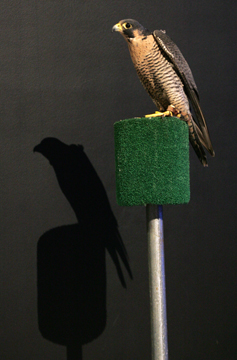
Peregrine falcons populations have made great strides since
’70s
Once endangered in the United States, peregrine falcon
populations have recovered so well that the U.S. Fish and Wildlife
Service has a proposal in the works that would allow falconers to
capture wild peregrines.
Falconers use trained birds to capture prey. The plan would
allow falconers to remove 105 peregrines from the wild per year.
Peregrines were put on the endangered species list almost 40 years
ago.
Peregrine falcons populations have made great strides since ’70s
Once endangered in the United States, peregrine falcon populations have recovered so well that the U.S. Fish and Wildlife Service has a proposal in the works that would allow falconers to capture wild peregrines.
Falconers use trained birds to capture prey. The plan would allow falconers to remove 105 peregrines from the wild per year. Peregrines were put on the endangered species list almost 40 years ago.
“This population, we feel, is robust enough to allow a limited capture,” said Nicholas Throckmorton, a spokesperson for the Wildlife Service.
Peregrine falcon recovery is one of conservation’s biggest success stories. The birds were nearly extinct in the United States by the mid-1970s, according to a Web site from the Wildlife Service. When they were listed as endangered, there were less than 324 peregrine falcons in the wild in the United States. Now there are more than 500 breeding pairs in California alone.
The proposal is appropriate, said Glenn Stewart, coordinator of the University of California, Santa Cruz Predatory Bird Research Group.
“Peregrine are now abundant,” he said.
The plan would not affect peregrines in California, Stewart said. In California, peregrines are listed as endangered.
Falconers in California could apply for a permit to capture a peregrine falcon from a state that does allow capture, Throckmorton said.
There are 4 subspecies of peregrine falcons, he said. The plan would allow the capture of the northern and arctic subspecies. Those birds breed in the Arctic Circle and migrate to the southeastern United States and Mexico.
The proposal would allow falconers to capture the birds from Sept. 20 through Oct. 20.
To limit the impact of removal on other subspecies, capture will only be allowed in Alaska and the southeastern United States. The other subspecies breed in different places.
Still, some in the birding community expressed concern.
“That’s just a straight analysis,” said Bob Power, executive director of the Santa Clara Valley Audubon Society, “Just kind of dealing with the cold facts. It doesn’t answer the question, ‘why should you do it?'”
Wild birds should stay wild, Power said.
“Why would anybody want to catch them and train them and keep them as pets?” Power said. “What public good would come of capturing these birds?”
The proposal does limit who could capture the birds. People would need to be licensed falconers, approved by federal and state governments, Throckmorton said.
Those who would like to weigh in on the proposal have until Feb. 11, 2008 to submit comments. The proposal is available online at http://www.fws.gov/migratorybirds/. Comments can be submitted to Fa*********@*ws.gov.









